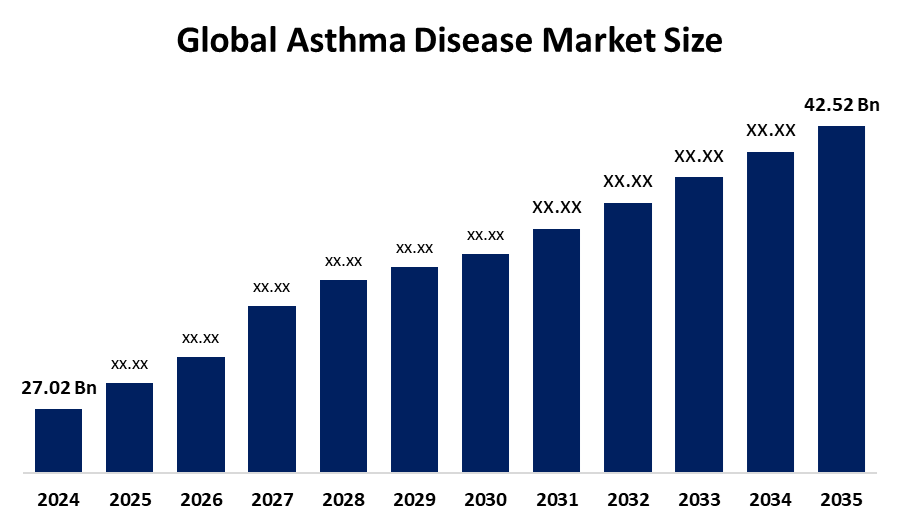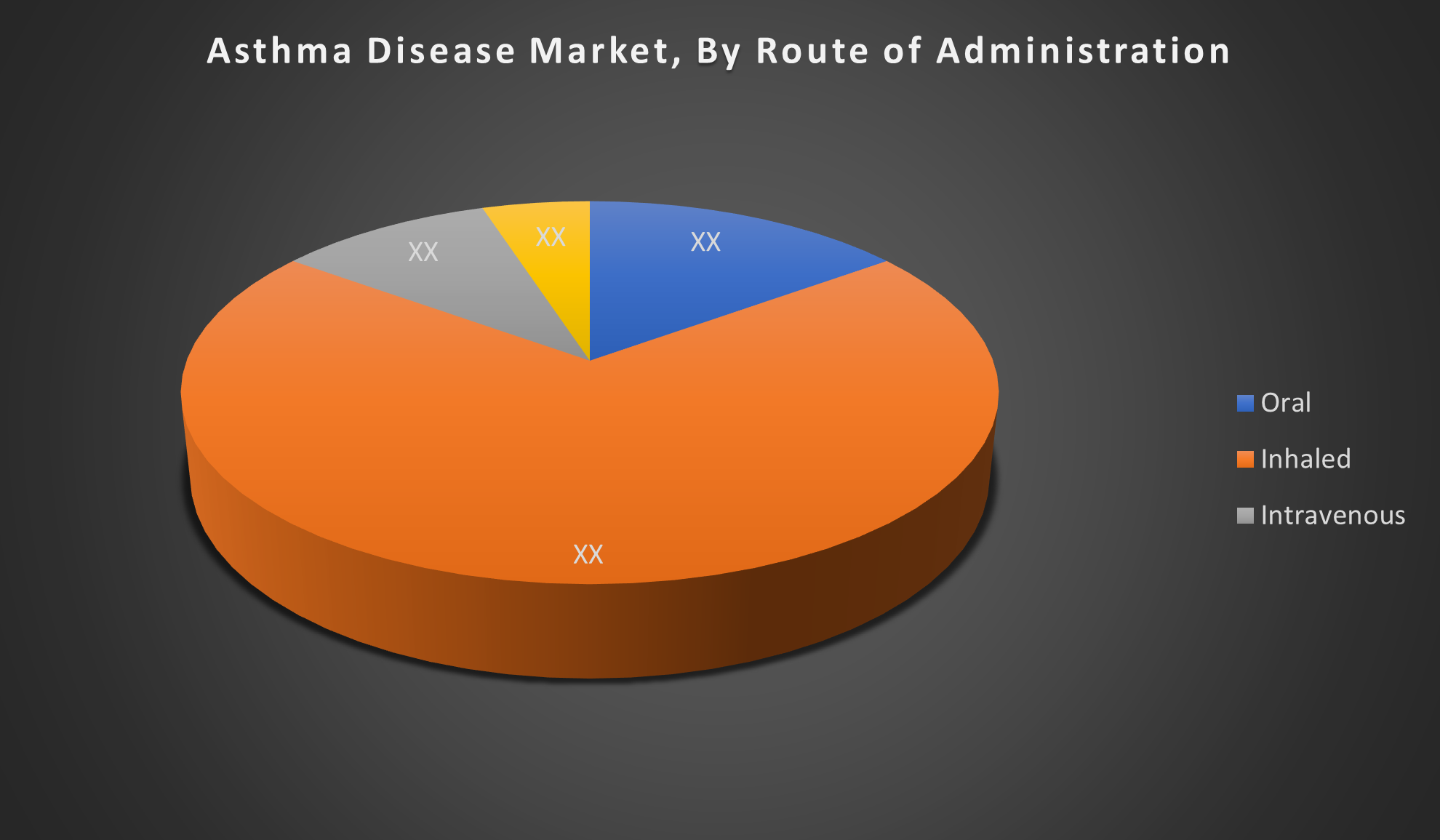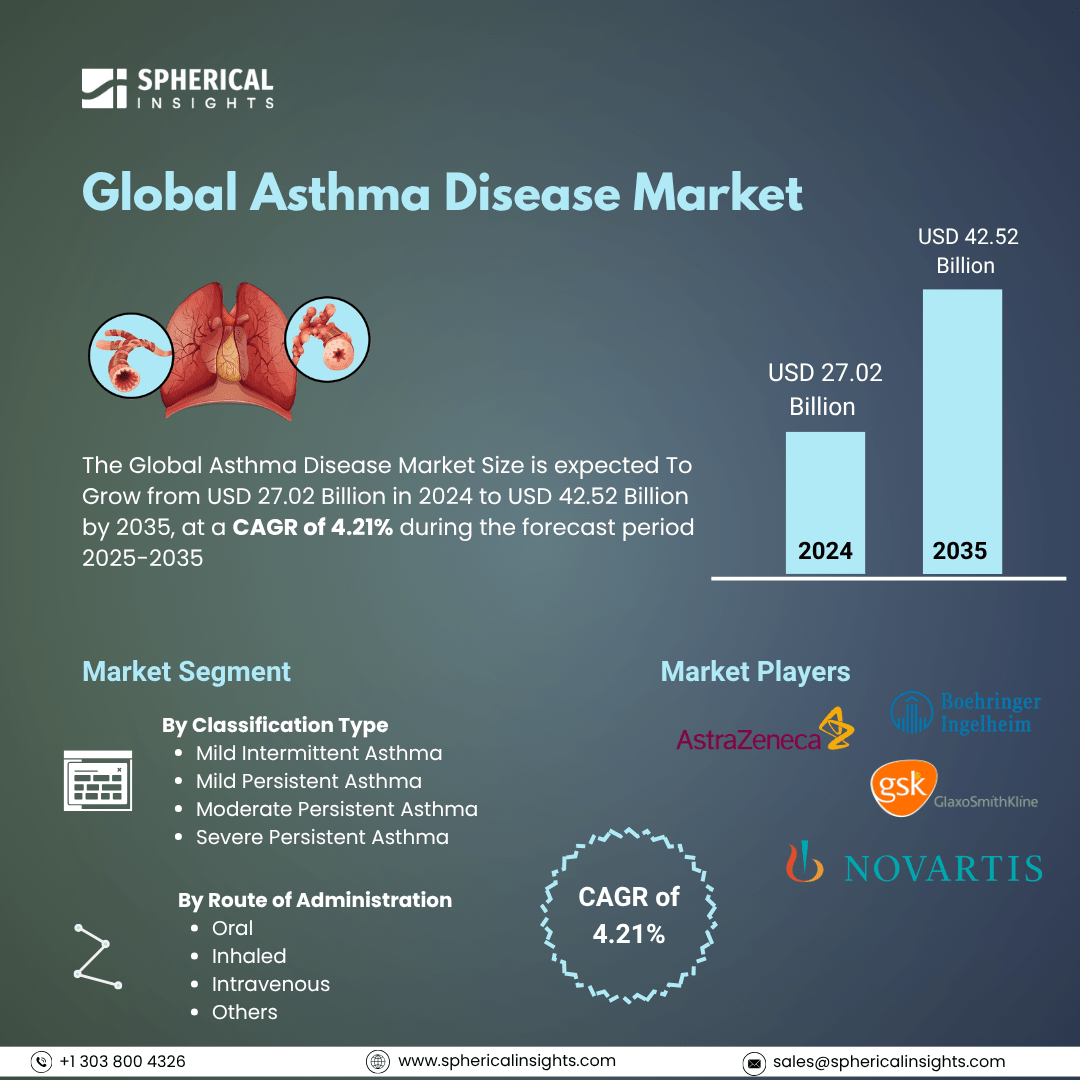- As per Spherical Insights & Consulting, The Global Asthma Disease Market Size is expected To Grow from USD 27.02 Billion in 2024 to USD 42.52 Billion by 2035, at a CAGR of 4.21% during the forecast period 2025-2035, owing to the launch of new therapies in the market and the rise in the number of cases.
- The leading Asthma Disease Market Companies such as AstraZeneca, GlaxoSmithKline, Novartis, Boehringer Ingelheim, Sanofi, Teva Pharmaceuticals, Merck & Co., Pfizer, Cipla, Sun Pharmaceutical, Mylan, Chiesi Farmaceutici, Roche, Regeneron Pharmaceuticals, Vectura Group, and Others.

Asthma Disease Treatment Market: Understanding and Treatment Algorithm:
Asthma is a chronic respiratory disease that causes inflammation and narrowing of the airways, leading to symptoms like wheezing, coughing, shortness of breath, and chest tightness. It can be triggered by allergens, pollution, or exercise and varies in severity. Asthma is manageable with medications and lifestyle adjustments, but not curable.
Asthma Disease Diagnosis:
Asthma diagnosis involves evaluating medical history, physical examination, and lung function tests. Common tests include spirometry to measure airflow, peak expiratory flow monitoring, and bronchoprovocation tests. Doctors may also assess allergy triggers through skin or blood tests. Accurate diagnosis helps tailor treatment plans and manage symptoms effectively.
Asthma Disease Treatment
Asthma treatment focuses on controlling symptoms and preventing attacks using long-term controller medications like inhaled corticosteroids and quick-relief bronchodilators for emergencies. Lifestyle changes, avoiding triggers, and regular monitoring are essential. In severe cases, biologic therapies and advanced treatments may be recommended to improve quality of life and reduce flare-ups.
Asthma Disease Epidemiology
The disease epidemiology covered in the report provides historical as well as forecasted epidemiology segmented by Total Diagnosed Incident Population of Asthma Disease, Gender-specific Diagnosed Incidence of Asthma Disease, Type-specific Diagnosed Incidence of Asthma Disease, Age-specific Diagnosed Incidence of Asthma Disease, Diagnosed Incident Population based on Primary Site of Asthma Disease, and Diagnosed Incident Population based on Histologic Classification of Asthma Disease Tumour in the global market covering North America, Europe, Asia-Pacific, Latin America, the Middle East, and Africa from 2024 to 2035.
Principal Insights
This section offers a global overview of asthma disease epidemiology in major markets worldwide.
Country Wise- Asthma Disease Multiforme Epidemiology
- The epidemiology segment provides Asthma Disease prevalence data and findings across key regions worldwide, including North America, Europe (Germany, France, Italy, Spain, and the United Kingdom), Asia-Pacific (including Japan), Latin America, the Middle East, and Africa.
Asthma Disease Recent Developments:
- In April 2024, Teva Pharmaceutical Industries Ltd. announced a clinical collaboration agreement with Launch Therapeutics to accelerate the development of its dual-action asthma rescue inhaler, TEV-‘248, combining fluticasone propionate and albuterol sulfate. Additionally, Teva entered a strategic development funding agreement with Abingworth, securing up to $150 million to support the program's clinical research.
Asthma Disease Marketed Drugs:
Symbicort (budesonide/formoterol) is a combination inhaler that contains a corticosteroid and a long-acting beta-agonist (LABA). It is FDA-approved for maintenance treatment of asthma and COPD, helping to reduce inflammation and relax airway muscles for improved breathing.
Singulair (montelukast) is a leukotriene receptor antagonist used to prevent asthma attacks and manage allergic rhinitis. It works by blocking leukotrienes, chemicals that cause airway inflammation and constriction, providing long-term control of asthma symptoms.
Xolair (omalizumab) is a monoclonal antibody that targets immunoglobulin E (IgE), reducing allergic responses in moderate to severe persistent asthma. It is administered via injection and used for patients whose asthma is not well controlled by inhaled corticosteroids.
Asthma Disease: Emerging Therapies
- Tezepelumab: Tezepelumab is a monoclonal antibody targeting thymic stromal lymphopoietin (TSLP), a key cytokine involved in airway inflammation. It is in late-stage clinical trials and has shown promise in reducing asthma exacerbations in patients with severe, uncontrolled asthma.
- GB001: GB001 is an oral small-molecule antagonist of prostaglandin D2 receptor 2 (DP2), aimed at reducing airway inflammation and improving lung function. It is currently being evaluated in clinical trials for moderate to severe asthma.
- Mepolizumab: Mepolizumab is an anti-IL-5 monoclonal antibody that reduces eosinophilic inflammation in severe asthma patients. It is approved for severe eosinophilic asthma, and ongoing research is exploring expanded uses and combination therapies.
- Fevipiprant: Fevipiprant is an oral prostaglandin D2 receptor antagonist under clinical investigation for treating asthma by blocking inflammatory pathways, potentially offering an alternative to corticosteroids with fewer side effects.
Asthma Disease Market Outlook
- The Asthma Disease Market involves the diagnosis, treatment, and management of asthma, a chronic respiratory condition causing airway inflammation and breathing difficulties. It includes inhalers, biologics, oral medications, and diagnostic tools aimed at controlling symptoms and preventing exacerbations globally.
- Increasing asthma prevalence, rising pollution levels, growing awareness and diagnosis rates, advancements in inhalation therapies, and expanding healthcare infrastructure in emerging markets are key factors driving market growth.
- Emerging biologic therapies, development of personalized medicine, expansion in untapped markets, growing pediatric asthma awareness, and technological innovations in drug delivery systems provide significant market growth opportunities.
- Governments are implementing public health campaigns, funding asthma research, improving air quality standards, and expanding access to affordable asthma medications to reduce disease burden and improve patient outcomes worldwide.
- Poor patient adherence to treatment and high costs of biologics limit market growth.
- The market is projected to grow steadily due to increasing asthma prevalence and ongoing innovations in treatment options, improving patient management.
Asthma Disease Market Segmentation
By Classification Type:
- Mild Intermittent Asthma
- Mild Persistent Asthma
- Moderate Persistent Asthma
- Severe Persistent Asthma

The Moderate Persistent Asthma segment holds the largest share in the global asthma disease market. This is due to its high prevalence, greater need for long-term controller medications, and frequent healthcare visits. Patients in this category often require consistent treatment, driving demand for inhaled corticosteroids, combination therapies, and specialist consultations, boosting market share.
By Route of Administration:
- Oral
- Inhaled
- Intravenous
- Others

The Inhaled route of administration holds the largest share in the global asthma disease market. Inhalation delivers medication directly to the lungs, ensuring faster relief with fewer systemic side effects. It is the preferred method for both maintenance and rescue therapies, making it widely adopted in clinical and home settings.
Regional Segment Analysis of the Asthma Disease Market
North America holds the largest share in the global asthma disease market due to its advanced healthcare infrastructure, high asthma awareness, and widespread use of inhaled therapies. The region benefits from routine asthma screening, established treatment guidelines, and high adoption of controller medications. Additionally, the presence of major pharmaceutical companies and consistent access to both prescription and over-the-counter treatments contribute to the region’s leading position in the asthma market.
Asia-Pacific is the fastest-growing region in the global asthma disease market, driven by increasing urbanization, rising pollution levels, and growing public awareness of asthma symptoms and treatments. Healthcare access is improving, especially in countries like India and China. Educational initiatives, government programs, and expanding insurance coverage are increasing diagnosis and treatment rates. These factors collectively contribute to the rapid market expansion seen throughout the Asia-Pacific region.
Asthma Disease Market Key Companies
- AstraZeneca
- GlaxoSmithKline
- Novartis
- Boehringer Ingelheim
- Sanofi
- Teva Pharmaceuticals
- Merck & Co.
- Pfizer
- Cipla
- Sun Pharmaceutical
- Mylan
- Chiesi Farmaceutici
- Roche
- Regeneron Pharmaceuticals
- Vectura Group
- Others
Asthma Disease Therapeutics Market Report Scope
- The Asthma Disease therapeutics market report provides a detailed overview, covering its causes, symptoms, disease progression, and existing treatment options.
- Detailed insights into Asthma Disease’s epidemiology and therapeutic approaches are included.
- Additionally, a comprehensive review of existing and emerging Asthma Disease therapies is provided, including an evaluation of new treatments expected to influence the current Asthma Disease treatment market landscape.
- The report includes a detailed review of the Asthma Disease therapeutics market, both historical and forecasted, highlighting the global drug reach.
- The Patient-Based Asthma Disease Market Forecasting report offers valuable insights into trends shaping the global Asthma Disease market, helping to develop effective business strategies.
Asthma Disease Treatment Market Report Insights
- Forecasting Market Trends Based on Patient Data and Disease Rates
- Asthma Disease Therapeutic Approaches in Asthma Disease
- Review Of Drugs in Development for Asthma Disease
- Market, Growth, and Trends in Asthma Disease
- Market Opportunities in Asthma Disease Treatment
- Effects Of Future Therapies on Asthma Disease Treatment.
Asthma Disease Treatment Market Report Key Strengths
- 15 Years Asthma Disease Market Forecast
- Global Coverage
- Asthma Disease Epidemiology Segmentation
- Key Cross Competition
Asthma Disease Treatment Market Report Assessment
- Present Practices in the Asthma Disease Treatment Market
- Review of Investigational Asthma Disease Drugs
- Attractiveness of the Asthma Disease Drug Market
- Asthma Disease Market Drivers
- Asthma Disease Market Barriers
- SWOT
- Attribute Analysis
Market Segment
This study forecasts revenue at the global, regional, and country levels from 2020 to 2035. Spherical Insights has segmented the asthma disease market based on the below-mentioned segments:
Global Asthma Disease Market, By Classification Type
- Mild Intermittent Asthma
- Mild Persistent Asthma
- Moderate Persistent Asthma
- Severe Persistent Asthma
Global Asthma Disease Market, By Route of Administration
- Oral
- Inhaled
- Intravenous
- Others
Global Asthma Disease Market, By Regional Analysis
- North America
- Europe
- Germany
- UK
- France
- Italy
- Spain
- Russia
- Rest of Europe
- Asia Pacific
- China
- Japan
- India
- South Korea
- Australia
- Rest of Asia Pacific
- South America
- Brazil
- Argentina
- Rest of South America
- Middle East & Africa
- UAE
- Saudi Arabia
- Qatar
- South Africa
- Rest of the Middle East & Africa






